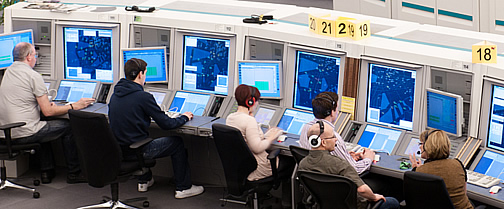The rules of radar
9 April 2014A lot of questions about radar have been raised recently as people are wondering about tracking aircraft and what information Air Traffic Controllers actually see on a screen when speaking with pilots.
So we thought it would be useful to look at radar in closer detail and explain the systems that we use here at NATS.
In air traffic control, it is standard international practice to monitor airspace using two radar systems – primary and secondary. The use of radar assists controllers in their main task of ensuring safe separation between aircraft. There are radar sites at many airports around the country and at other strategic sites. These ensure that the controllers who work at the various units around the UK receive the best possible picture and information from the radar network.
Primary Radar
Primary radar is based on the earliest form of radar developed in the 1930s and provides only basic information about the position of an aircraft in relation to the radar, using reflected radio signals. It will show all aircraft within its coverage and will also show other objects like high terrain, certain weather and possibly large flocks of birds. The advantage of primary radar is that all of the equipment is on the ground and nothing is needed from aircraft systems.
Secondary Radar
Secondary Radar is selective, and only displays information from aircraft equipped with a transponder. All aircraft operating within controlled or special rules airspace must be equipped with a serviceable transponder. This rule also applies to aircraft operating outside controlled airspace above FL 100 (flight level 10,000ft).
Before an aircraft departs from a major airfield or before it enters the airways systems, it is allocated an individual four-digit code, which the pilot dials up in the transponder. When the aircraft gets airborne, or before it enters the airways systems, the ground-based radar interrogates the transponder. When it recognises the code, which it allocated to that particular flight, the aircraft’s height information and callsign, is displayed to the controller in the form of a label next to the position of the aircraft. The latest secondary radars can also download selected additional data from the aircraft, such as the flight level the pilot has selected. This allows controllers to monitor an aircraft’s intentions as well as where it is.
The controller is also able to display maps of airways and upper air routes as well as coastlines and danger areas on the display. These, as well as the displayed information about the aircraft, assist the controller in ensuring the aircraft flies safely along the route it wishes to fly.
However, once an aircraft is more than 240km (150 miles) out to sea, radar coverage fades and air crew keep in touch with air traffic control and other aircraft using high-frequency radio and other systems.
Automatic Dependent Surveillance Broadcast (ADS-B)
ADS-B is an emerging technology using GPS navigation that is at the forefront of the next generation of air traffic control tools.
It makes aircraft equipped with the right equipment (approximately 70% of commercial aircraft at the moment) visible in real time and is anticipated to replace radar for operational use once it is fully developed. NATS is currently evaluating ADS-B and you can see an example of ADS-B in action on our website.
Let us know if you have any questions on this topic and we will try our best to answer them.
Comments
Please respect our commenting policy and guidelines when posting on this website.






09.04.2014
20:20
barney
What you didn’t mention David, are the methods of determining the identification of an aircraft on Primary. It’s not just as easy as ‘there it is on the screen’ as, unlike Secondary, it’s not readily apparent which return is which aircraft. In other words, an ATCO cannot just point to a Primary return and say ‘that’s Bigjet371’. He/she has to actively identify the aircraft by one of several methods.
04.07.2018
14:54
Mike Ellis
The distinction between Mode A, Mode C and Mode S secondary radar would be worth breaking out – Mode C doesn’t include the callsign (although this can sometimes be inferred if the Mode-A 4-digit code is only allocated to a single aircraft). Mode-A doesn’t include the altitude or callsign. Mode S-ES (non-ADS-B) also probably ought to be covered.